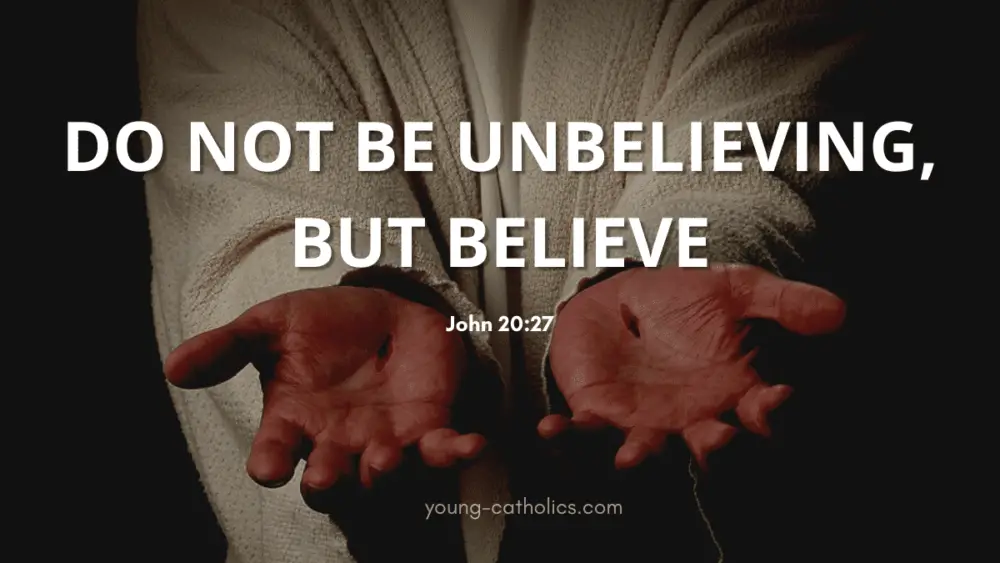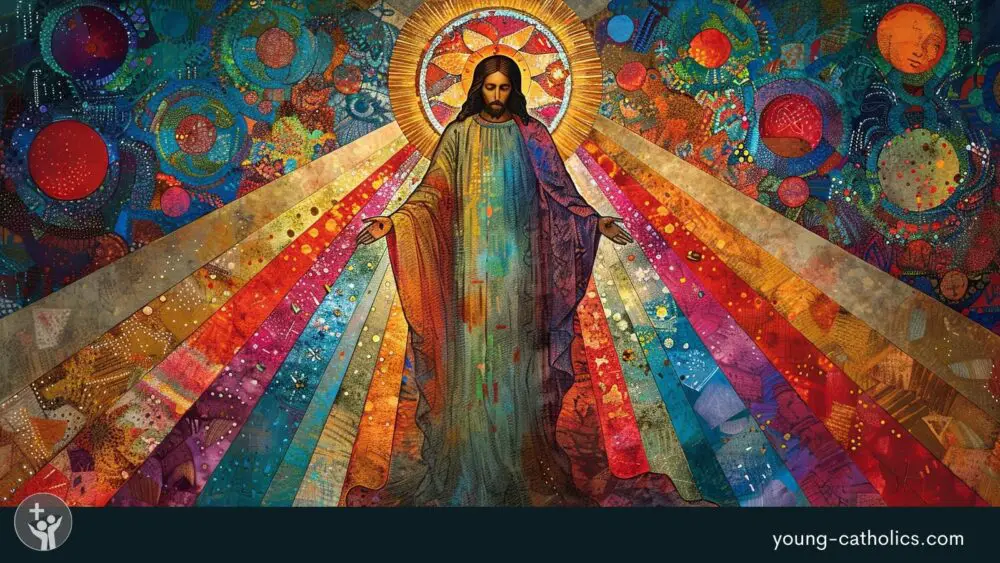2nd Sunday of Easter Year B
Divine Mercy Sunday
Sunday April 4, 2027

Mass Readings for Divine Mercy Sunday Year B
- First Reading – Acts 4:32-35: The early believers were united, sharing possessions and resources. The apostles’ powerful testimony about Jesus’ resurrection earned them high regard. They distributed funds from sold properties to meet everyone’s needs, ensuring no one was in need.
- Responsorial Psalm – Psalm 118: Israel, Aaron’s descendants, and the God-fearing proclaim God’s enduring mercy. He answers in distress, providing strength and salvation. The rejected stone becomes the cornerstone, a marvelous act of the Lord.
- Second Reading – 1 John 5:1-6: Belief in Jesus as the Christ shows we are born of God. Loving God and His children means obeying His commandments, which are not burdensome. Our faith in Jesus as God’s Son overcomes the world, affirmed by the Spirit of truth.
- Gospel – John 20:19-31: In a locked room, Jesus appeared to his disciples, offering peace and showing his wounds, which brought them joy. He empowered them with the Holy Spirit and the authority to forgive sins. Thomas, absent initially, doubted their testimony. Later, Jesus appeared again, inviting Thomas to touch his wounds, leading to Thomas’ declaration of faith. Jesus blessed future believers who wouldn’t see yet believe. These events were recorded to affirm faith in Jesus as the Christ.
Upcoming dates: April 4, 2027, April 28, 2030, April 24, 2033
Have you come to believe because you have seen me? Blessed are those who have not seen and have believed.
John 20:29
Themes for Divine Mercy Sunday Year B
Divine Mercy Sunday Year B celebrates God’s mercy and the hope we receive through Jesus’ Resurrection. The readings highlight forgiveness, faith, community, and the power of belief.
- Mercy and Forgiveness: Jesus gives His disciples the power to forgive sins. This shows God’s mercy and invites us to seek forgiveness and offer mercy to others.
- Faith Amid Doubt: Thomas struggles to believe without seeing Jesus. His story reminds us that doubt is part of faith, and Jesus meets us in our struggles.
- Peace Through Christ: Jesus brings peace to His fearful disciples. His presence calms their fears and gives them courage to continue His mission.
- Power of Community: The early Christians shared everything and supported one another. Their unity shows the importance of community in living out faith and mercy.
- Victory Through Faith: Belief in Jesus overcomes the world’s challenges. This faith gives us strength and hope, even in difficult times.
- Blessed Are Believers: Jesus blesses those who believe without seeing. This encourages us to trust in Him and grow in faith, even when we cannot see Him.
Divine Mercy Sunday Year B invites us to receive God’s mercy and share it with others. It calls us to live in faith, community, and peace, trusting in Jesus’ presence and love.
Resources for Divine Mercy Sunday Year B
Sunday April 4, 2027

All Things Visible and Invisible – Discussion and Reflection Questions
This lesson plan helps youth explore faith and belief through the story of Thomas, featured in the Gospel for Divine Mercy Sunday Year B. Thomas struggled to believe in Jesus’ Resurrection until he saw Jesus for himself. His story shows that doubt is a natural part of faith and that Jesus meets us with patience and understanding.
Divine Mercy Sunday Year B reminds us that Jesus is merciful even when we struggle to believe. He invites us to bring our doubts to Him and to trust that He will help us grow in faith. This lesson encourages young people to seek God honestly, knowing that questioning and searching are part of the journey.

Divine Mercy Chaplet
The Divine Mercy Chaplet is a prayer that asks for God’s mercy through Jesus’ sacrifice. It was revealed to Saint Faustina Kowalska, who was called to share this devotion with the world. The chaplet reflects on Jesus’ Passion and reminds us to trust in His mercy and to show mercy to others.
Divine Mercy Sunday Year B celebrates God’s mercy shown through Jesus’ Resurrection and forgiveness. Praying the Divine Mercy Chaplet helps us remember that we depend on His mercy. It invites us to trust in Jesus and to be instruments of mercy and hope in the world.

The Acts of the Apostles
On Divine Mercy Sunday Year B, the first reading from the Acts of the Apostles brings to light the pivotal roles of the Holy Spirit, community, and evangelism in the early Christian Church. It portrays the Holy Spirit as crucial for guiding and empowering the apostles in their mission. This day emphasizes the unity and shared life of the early believers, serving as a powerful example of communal living in faith and love.
Moreover, the Acts inspire us with the apostles’ zeal for evangelism, urging modern believers to actively share the Gospel. These themes underscore the importance of Divine Mercy Sunday as a time to reflect on God’s mercy, the strength of community, and our call to spread the good news with the support of the Holy Spirit. Learn more.

Psalm 118
On Divine Mercy Sunday Year B, Psalm 118 serves as a resonant call to trust. This psalm teaches that God’s love lasts forever. The writer went through struggles but did not give up. He knew that God was with him. He tells others to trust in God, not in people or things that do not last. God gives strength in every situation.
This psalm also points to Jesus. People shouted its words when He entered Jerusalem. Jesus later used a verse from it to show that He is the foundation of faith. Even when He was rejected, God’s plan was greater. Psalm 118 calls us to rely on God, give thanks, and know that His love never fails.

1 John: Exploring the Depths of Love and Truth
On Divine Mercy Sunday Year B, the second reading from the First Letter of John illuminates the profound nature of God’s love and the imperative to love one another, mirroring the themes of mercy and forgiveness that this day celebrates. It beckons us to ponder our relationship with God, questioning if we truly grasp and embody His love and truth in our lives.
This day offers a special opportunity for reflection on living in the light of God’s love, challenging us to extend mercy, kindness, and forgiveness to those around us, just as we are embraced by Divine Mercy. It underscores the essence of Divine Mercy Sunday: to deepen our connection with God, enhance our relationships through love, and live authentically in His truth and light. Learn more.

Resources and Reflections for the Gospel of John
On Divine Mercy Sunday Year B, the Gospel from John 20:19-31 deeply resonates with the themes of forgiveness, faith, and God’s boundless mercy.
It recounts a moment when Jesus appears to his disciples, offering peace and the Holy Spirit, emphasizing the power of forgiveness. The encounter with doubting Thomas highlights Jesus’ compassion and patience, inviting all to a deeper faith. This Gospel passage underscores the essence of Divine Mercy Sunday: Jesus’ mercy towards us, his call for us to believe without seeing, and his commissioning us to spread this mercy. It reminds Catholics of the profound hope and salvation found in faith in Jesus, encouraging us to live out these values in our lives, sharing God’s love with others. Learn more about the Gospel of John.
Homilies and Commentaries for Divine Mercy Sunday Year B
Sunday April 4, 2027
Do You Struggle to Believe?
In his homily for Divine Mercy Sunday Year B, Bishop Robert Barron reflects on Jesus’ appearance to the disciples after His Resurrection. He explains that Jesus offers peace and shows His wounds, reminding us of our sin but also of His forgiving love. Bishop Barron emphasizes that nothing can separate us from God’s love, even our worst sins, because Jesus returns with mercy and peace.
Bishop Barron also explores Thomas’ doubt and his journey to faith. He explains that Thomas wanted proof on his own terms but ultimately found faith by trusting Jesus. Bishop Barron highlights that true faith goes beyond reason and grows within the community of the Church. He encourages those who struggle with doubt to seek faith like Thomas, who made the greatest declaration of Jesus’ divinity in the New Testament.
The Day the Lord Made
In his commentary for Divine Mercy Sunday Year B, Scott Hahn explains how we experience the risen Jesus through the Church and the sacraments. He highlights that, like the apostles, we encounter Jesus in the breaking of the bread during the Eucharist. Hahn connects the Gospel scenes to the Mass, showing how Jesus brings peace and His real presence to His followers.
Hahn also emphasizes the importance of the apostles’ witness, which has been passed down through the Church. Through their teachings and traditions, we come to know Jesus as our Lord and Savior. Scott Hahn’s reflection on Divine Mercy Sunday Year B invites us to approach the Eucharist with joy, recognizing it as an encounter with the risen Christ.
Reflection for Divine Mercy Sunday Year B
Divine Mercy Sunday Year B invites us to reflect on Jesus’ mercy and love. The readings show us His understanding of doubt, His gift of forgiveness, and the importance of living in community. These reflections explore how we can grow in faith, share mercy, and support one another.
Doubting Thomas
In the Gospel for Divine Mercy Sunday Year B, we hear the story of Thomas, who doubts the Resurrection. When the other disciples tell him that they have seen the risen Jesus, Thomas refuses to believe without physical proof. He wants to see and touch Jesus’ wounds before he believes. This honest doubt does not make him a lesser disciple. Instead, it shows his need for understanding and truth.
A week later, Jesus appears again, this time with Thomas present. Jesus invites him to touch His wounds and believe. Jesus does not scold Thomas for his doubt. Instead, He meets Thomas where he is and gives him what he needs to believe. This moment shows that Jesus understands our struggles and questions. He is patient and loving, even when we are unsure.
Thomas responds with a powerful declaration of faith: “My Lord and my God!” His doubt leads him to a deeper faith. He shows us that questioning is not the end of faith but a step on the journey. His story encourages us to bring our doubts and questions to Jesus.
Divine Mercy Sunday Year B teaches us that faith is not always easy. Doubts and questions are part of the journey. Like Thomas, we are invited to seek the truth and grow in faith. Jesus meets us in our struggles and invites us to trust Him.
Forgiveness and Reconciliation
Divine Mercy Sunday Year B highlights Jesus’ message of forgiveness and reconciliation. When Jesus appears to His disciples, He offers them peace. He does not scold them for abandoning Him during His crucifixion. Instead, He forgives them and gives them the Holy Spirit, empowering them to continue His mission of forgiveness.
Jesus gives the disciples the authority to forgive sins. This shows the power of mercy and reconciliation. It also shows that forgiveness is not just about the past but about building a better future. By forgiving, we open the door to healing and peace.
This call to forgiveness is not just for the disciples but for all of us. We are invited to forgive others as Jesus forgives us. This is not always easy, but it is the way to true peace and reconciliation. Forgiveness helps us let go of anger and hurt, freeing us to live in peace.
Divine Mercy Sunday Year B reminds us that forgiveness is a gift we receive and a gift we must give. Jesus shows us how to forgive with love and mercy. We are called to bring this forgiveness to our families, communities, and the world.
The Power of Community
The first reading for Divine Mercy Sunday Year B shows the early Christian community living in unity and generosity. They shared everything they had and took care of each other. No one was in need because they supported one another. This example shows the power of community in living out faith.
This sense of community was not just about sharing possessions. It was about sharing faith, hope, and love. They prayed together, learned from the apostles, and supported each other in their struggles. Their unity was a witness to the world of the power of Jesus’ Resurrection and love.
Community is essential for growing in faith. It helps us face doubts, challenges, and fears. Just as the early Christians encouraged one another, we are called to build supportive and loving communities. This includes our families, parishes, and friendships.
Divine Mercy Sunday Year B reminds us that faith is not meant to be lived alone. We need each other’s support and encouragement. We are called to create communities of love, mercy, and hope. When we live in unity, we reflect the love of Christ to the world.
Divine Mercy Sunday Year B challenges us to trust in Jesus’ mercy and share it with others. We are called to bring our doubts to Him, forgive as we are forgiven, and live in loving community. May these reflections inspire us to live out our faith with courage and compassion.
Prayer
Lord Jesus, thank You for Your mercy and love. Help us to trust You, even in our doubts. Give us the courage to forgive others and to live in unity as Your followers. May we share Your peace and hope with the world. Amen.
Reflection Questions for Divine Mercy Sunday Year B
- What doubts or questions do I need to bring to Jesus?
- How can I deepen my faith like Thomas?
- In what ways do I need to forgive others or seek forgiveness?
- How can I be an instrument of peace and reconciliation?
- What can I learn from the early Christian community’s unity and generosity?
- How can I support my faith community more fully?
- Where do I need God’s mercy in my life right now?
- How can I share God’s mercy with others?
- What is Jesus inviting me to believe more deeply?
- How can I live out the call to love and forgive as Jesus did?
Quotes and Social Media Graphics for Divine Mercy Sunday Year B


Music Suggestions for Divine Mercy Sunday Year B
Sunday April 4, 2027
These music selections reflect the themes of mercy, forgiveness, faith, and community found in the readings for Divine Mercy Sunday Year B. Some songs celebrate God’s mercy and the peace Jesus offers, while others focus on trust and faith even when we have doubts. The music also encourages unity and love within the Christian community. These songs help us reflect on God’s mercy and inspire us to share that mercy with others.
- Alleluia! Love Is Alive by Steve Angrisano, Jesse Manibusan & Sarah Hart
- Because He Lives by Matt Maher
- Bring Forth the Kingdom by Marty Haugen
- Bring Your Hand and Feel the Place of the Nails by Steve Angrisano, Sarah Hart & Curtis Stephan
- By Our Love by Tom Kendzia
- Church of God Elect and Glorious by Rowland H. Pritchard, James E. Seddon & Randall Debruyn
- Divine Mercy Chaplet in Song by Steve Angrisano & Sarah Hart
- Every New Morning by Audrey Assad
- Eye Has Not Seen by Marty Haugen
- Faustina’s Song by Mark Mallett
- Glory and Praise to Our God by Dan Schutte
- Give Thanks to the Lord by Dan Schutte
- Give Thanks to the Lord (Psalm 118) by Tom Kendzia
- Glorious Day by Passion & Kristian Stanfill
- God of Mercy and Compassion by The Daughters of Mary
- Jesus You Are Mercy by Donna Cori Gibson
- Join in the Dance by Dan Schutte
- Lord of the Dance by Tom Kendzia & Sydney B. Carter
- One Thing Remains by Passion & Kristian Stanfill
- Peace My Friend by Jamie Rickert
- Peace, My Friends by Ray Repp
- Peace Is Flowing Like a River by Carey Landry
- Psalm 118 (Alleluia) by Bob Hurd & Ken Canedo
- Sing a New Church by Delores Dufner OSB & Jeffrey Honoré, & Randall DeBruyn
- This Is Amazing Grace by Phil Wickham
- The Jesus Song by Tom Booth
- There’s a Wideness in God’s Mercy by Fredrick William Faber
- We Walk by Faith by William Croft & Henry Alford
Music directors and musicians are encouraged to explore these selections for Divine Mercy Sunday Year B. These songs can enhance worship and help the congregation connect with the message of mercy and faith. If you have other songs that fit these themes, please share your suggestions in the comments.
Frequently Asked Questions for Divine Mercy Sunday Year B
What date is Divine Mercy Sunday Year B?
The next date is Sunday April 4, 2027.
For other years see the links below:
Divine Mercy Sunday Year A
Divine Mercy Sunday Year C
What are the Mass readings for Divine Mercy Sunday Year B?
The Catholic Mass readings for Sunday April 4, 2027 are:
First Reading – Acts 4:32-35: Unity and Generosity in the Early Christian Community
Responsorial Psalm – Psalm 118: Praise and Thanksgiving to the Lord
Second Reading – 1 John 5:1-6: The Connection Between Faith, Love, and Obedience
Gospel – John 20:19-31: The Appearance of the Risen Jesus to His Disciples
What is the main message of Divine Mercy Sunday Year B?
Divine Mercy Sunday Year B celebrates God’s mercy and forgiveness through Jesus’ Resurrection. It invites us to trust in His love and to show mercy to others.
Why did Jesus show His wounds to the disciples?
Jesus showed His wounds to prove He was truly risen. The wounds also remind us of His sacrifice and the forgiveness He offers.
Why did Jesus breathe on the disciples?
Jesus breathed on them to give them the Holy Spirit. This empowered them to forgive sins and continue His mission.
What does Peace be with you mean?
Jesus’ greeting of peace is a gift of calm and reconciliation. It shows that He forgives the disciples and brings them hope and courage.
Why did Thomas doubt the Resurrection?
Thomas doubted because he was not there when Jesus first appeared. He wanted physical proof to believe, showing that doubt can be part of the faith journey.
What does Jesus’ response to Thomas teach us?
Jesus did not criticize Thomas for his doubt. Instead, He met him with understanding, showing that honest questions can lead to deeper faith.
How does Divine Mercy Sunday Year B show God’s forgiveness?
Divine Mercy Sunday Year B shows that Jesus brings peace and forgiveness, even to those who doubted or abandoned Him. It reminds us that His mercy is greater than our failures.
Why is community important in the readings?
The early Christians shared everything and supported each other. This shows that faith grows in community, and we need each other for support and encouragement.
What is the importance of believing without seeing?
Jesus blesses those who believe without physical proof. This encourages us to trust in Him through faith and the witness of others.
How can we live out the message of Divine Mercy Sunday Year B?
We can live it out by seeking forgiveness, showing mercy, and trusting in Jesus’ love. We are also called to support each other in faith and build loving communities.
Mercy, Faith, and Community
Divine Mercy Sunday Year B celebrates God’s mercy shown through Jesus’ Resurrection. In the Gospel, Jesus appears to His disciples, offering peace and the power to forgive sins. He shows mercy and understanding to Thomas, who struggles with doubt. This reminds us that faith is a journey, and Jesus meets us with patience and love.
The first reading shows the early Christian community united in faith and generosity. They shared everything and supported each other. Their example teaches us the power of community and the importance of caring for one another.
The second reading speaks of victory through faith in Jesus. Believing in Him gives us strength to overcome life’s challenges. This faith unites us as children of God, called to love and obey His commandments.
Divine Mercy Sunday Year B invites us to receive God’s mercy and share it with others. It calls us to live in faith, peace, and community.
Your Turn
Divine Mercy Sunday Year B reminds us of God’s endless mercy and love. It invites us to reflect on our faith journey, including moments of doubt and struggles. The story of Thomas encourages us to bring our questions to Jesus, trusting in His patience and understanding.
Reflect on the readings and consider how they speak to you. Share your thoughts and experiences in the comment section. How has God’s mercy touched your life? How can you share that mercy with others? Your insights can inspire and encourage others on their faith journey.


Leave a Reply